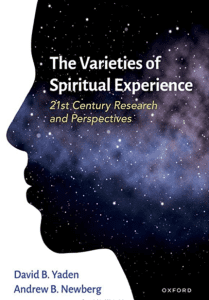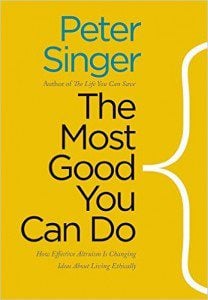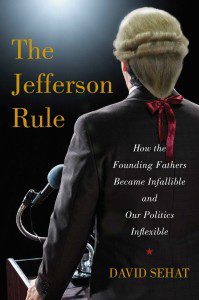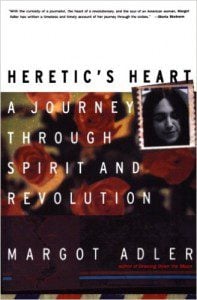The first peace, which is the most important, is that which comes within the souls of people when they realize their relationship, their oneness, with the universe and all its powers, and when they realize that at the center of the universe dwells Wakan-Tanka , and that this center is really everywhere, it is within each of us. This is the real peace, and the others are but reflections of this. The second peace is that which is made between two individuals, and the third is that which is made between two nations. But above all you should understand that there can never be peace between nations until there is known that true peace, which, as I have often said, is within the souls of [humans].
—The Sacred Pipe: Black Elk’s Account of the Seven Rites of the Oglala Sioux
One of the most formative influences in my life is the summer camp I attended for many years in western North Carolina. Starting at age ten, I spent two weeks there each summer as a camper. When I turned 16 and was eligible to be a counselor, the time I spent at camp quickly escalated to almost three months annually. This trend continued through college until I went to seminary and my summers became occupied with other responsibilities. All total, I have spent well more than a year of my life at that camp.
That camp and its staff strengthened my love for nature. They taught me how to pitch a tent, build a fire, and read a trail map. They taught me how to play guitar, be a lifeguard, and approach religion in a more open-minded, intellectual way. This camp like, like many other summer camps in North American during the 20th century also had a strong Native American theme. There were brightly painted totem poles that towered prominently throughout the camp grounds. The age groups were named after Native American tribes: Cheyenne, Cherokee, Comanche, Apache, Seminole, and Choctaw. And each Sunday evening we dressed up like Indians and ascended the mountain for Council Ring. Be assured that I will momentarily address the problematic aspects of privileged white folk playing at Native American Spirituality. But first let us travel a little farther down the road of how, for better or worse, Native American themes in summer camps were formational for both myself and many other North American children in the past few decades.
The rhythm of camp life built to a peak and resolution each Sunday. We were allowed to sleep late. Then in the late morning each age group would gather for an outdoor worship service. And I think that’s where I first learned, in good Emersonian fashion, that sitting on the grass, under the shade of trees, and beneath the canopy of the sky felt as much or more like an authentic sacred space for worship than my childhood sanctuary, where the stained glass obscured any view of the world outside the church walls. I learned on those summer camp Sunday mornings that in nature it was easiest for me to connect to what we Unitarian Universalists call the “direct experience of transcending mystery and wonder.”
As I said before, on Sunday evenings we would ascend the mountain to sit in a large circle around a giant fire for Council Ring. And in retrospect my early religious experience was shaped by that contrast between the Christian-themed Sunday morning worship under the bright light of the sun and Native American-themed Sunday night Council Ring lit only by moon, stars, and firelight. The experience for myself and many campers, if only on an intuitive level, was that these two different spiritual experiences were both good, both vital, and both desirable. But after experiencing a spirituality of Sunday morning and a spirituality of Sunday night at camp, many of us sensed something was missing when we returned home and had access only to Christian-themed Sunday morning religion. And a longing to return to a fuller experience of life and spirituality is part of what kept us coming back to camp for so many years.
Another way of speaking about this dynamic is that I believe many, if not most or all of us, long for a spirituality that speaks to our whole self, not just part or half us. We long for a spirituality that addressed the fullness of mind and body, masculine and feminine, reason and emotion, action and contemplation, peace and justice. I do not mean to imply, however, that supplementing European Christianity with Native American Spirituality is the only way to experience this sort of union and balance. Another example is the twentieth-century Benedictine monk Bede Griffiths (1906-1993). Griffiths’ birth name was Alan, and he was born to a middle-class family in Surrey, England. Even as a Benedictine monk, whose whole life was immersed in European Christian spirituality, Griffiths felt something was missing. This longing eventually led him to move permanently to India, where he said he discovered “the other half of my soul.” He settled in an ashram known as Shantivanam or “Forest of Peace,” which is Christian in faith (in a broad, open-minded sense), but Hindu in lifestyle. Out of this experience he wrote many books on Hindu-Christian dialogue, and over time became known as Swami Dayananda, which in Sanskrit means “bliss of compassion.”
Let me give you one more example of two different spiritualities supplementing one another. A few weeks ago we heard a wonderful performance in this sanctuary of the Indigo Girls’ song “Closer to Fine.” Many of that group’s songs are religiously themed. And some of you may know that Emily Saliers, one of the group’s two members, has a father named Don Saliers, who is an emeritus theology of worship professor at Emory University. They have both spoken and written about the similarities and differences between the music the Indigo Girls play in clubs on Saturday night and the music her father help play and sing only hours later in houses of worship on Sunday morning.
Stereotypically, the folk-rock music at an Indigo Girls’ concert on Saturday night is more embodied, active, and social justice oriented. The music at many houses of worship on Sunday morning is more contemplative, peaceful, and worshipful in the traditional sense of that word. Part of the point Don and Emily Saliers are trying to make is that Sunday morning music may need to borrow some lessons from Saturday night and become more embodied, active, and social justice oriented. Likewise, we may need to consider the ways that Saturday evening rock concerts can also be an experience of worship where we feel connected and lifted up. In different ways, each of these examples — summer camp Council Ring, Christian monks traveling to India, and folk rockers in dialogue with worship professors — all point to a longing for wholeness, for the “other half of my soul” — for both mind and body, masculine and feminine, reason and emotion, action and contemplation, peace and justice.
And this longing for wholeness is one of the many reasons I am grateful that Unitarian Universalism draws not from one source, but from Six Sources:
- Direct experience of transcending mystery and wonder….
- Words and deeds of prophetic women and men….
- Wisdom from the world’s religions….
- Jewish and Christian teachings…..
- Humanist teachings… and
- Spiritual teachings of earth-centered traditions.
But the way in which we draw from each of these traditions matters — particularly for those of us like me who are heir to white male privilege that is rooted in the Western world’s tradition of patriarchy and colonialism.
When examined through a critical lens, my experience at summer camp of dressing up like an American Indian and going to Council Ring begins to look like one more example of white privilege, patriarchy, and colonialism. Unlike Bede Griffiths who went to India and said, “Teach me. Let me learn from you” or the Indigo Girl and her father, who met as equals to dialogue about different styles of music, white children playing at Native American spirituality looks a lot like a powerful cultural group taking yet one more thing from a marginalized indigenous people from who so much has already been taken.
So on one hand, I am deeply grateful for my childhood immersion into Native American Spirituality (even if it was in a compromised form) because it helped plant in my life the seed of honoring silence, the seed of recognizing that there is perhaps — in some sense — one “Great Mystery” beyond the sectarianism of the Judeo-Christian-Islamic God, and the seed of environmentalism and considering the impact of your actions even to the Seventh Generation to come after you. For example, the quote from Black Elk that was read earlier sounds a lot like what UUs call the “interdependent web of all existence” — that “first peace, which is the most important,” and which comes from the realization that is that at the center of the universe dwells [The Great Mystery] “and that this center is really everywhere, it is within each of us.” Accordingly, I would even go so far as to say that my early exposure to Native American Spirituality helped plant the seeds that helped draw me years later to Unitarian Universalism.
At the same time, I’m also grateful that during my final years at that camp, I was able to serve on a team that helped transition the camp away from a Native American theme to a Ecology-based theme. The totem poles were taken down, the campers stopped dressing up like American Indians, and the names of the age groups were changed from Indian tribes to the names of tree leaves — Buckeye, Birch, Hickory, Hemlock, Poplar, and Sycamore — as part of an effort to inculcate an awareness of the indigenous flora and fauna. There does, however, continue to be opportunities for campers to learn specifically about the history and lore of the Cherokee tribe, who are native to the mountains of western North Carolina.
Not long after helping facilitate this major thematic-shift at that camp, I was called to serve as a the associate pastor at a congregation in northeast Louisiana. Upon my arrival I was dismayed to see that the local university’s mascot was the “Indians,” including, of course, a caricatured mascot of a Native American. Now I realize that I am delving into dangerous territory here for fans of such team as the Atlanta Braves, Florida Seminoles, and Washington Redskins, but allow me for now to share more specifically about this one university.
About three years after my arrival, I was pleased to learn that the local university had finally decided to rename its mascot after pressure from the NCAA for schools to cease using names that are “hostile and abusive” to Native Americans. Then I learned that the replacement that continues to this day was to be the “Warhawks.” I wrote a letter to the editor to protest of this use of war imagery for college athletics, but it was to no avail.
There is a lot more I could say about that particular debate, but as we consider Native American Spirituality this morning, I think it is important to spend some time listening to what some Native Americans have said about this issue. One famous statement was made in 1993 at the Lakota Summit V, an international gathering of U.S. and Canadian Lakota, Dakota and Nakota Nations. The statement was provocatively titled, “Declaration of War Against Exploiters of Lakota Spirituality.” And while I do find a “Declaration of War Against Exploiters of Lakota Spirituality” to be provocative, even exaggerated, keep in mind all the language we have heard for years from the U.S. Government about the war on drugs and the war on terror. And remember all the centuries of deaths, betrayals, and insults out of which this “Declaration of War Against Exploiters of Lakota Spirituality” arises.
The statement is short — only about two pages or 800 words — but for now I invite you to hear a few excerpts from this declaration:
for too long we have suffered the unspeakable indignity of having our most precious Lakota ceremonies and spiritual practices desecrated, mocked and abused by non-Indian “wannabes,” hucksters, cultists, commercial profiteers and self-styled “New Age shamans” and their followers; . . . with horror and outrage we see this disgraceful expropriation of our sacred Lakota traditions has reached epidemic proportions in urban areas throughout the country; . . . our precious Sacred Pipe is being desecrated through the sale of pipestone pipes at flea markets, powwows, and “New Age” retail stores; … pseudo-religious corporations have been formed to charge people money for admission into phony “sweatlodges” and “vision quest” programs; . . . and the television and film industry continues to saturate the entertainment media with vulgar, sensationalist and grossly distorted representations of Lakota spirituality and culture which reinforce the public’s negative stereotyping of Indian people and which gravely impair the self-esteem of our children….
The declaration continues, but this excerpt gives you a taste of the anger many Native Americans rightly feel when they see their sacred rituals commodified for the profit of non-Native Americans or used in ways that seem sacrilegious to the Native Americans even if the non-Native Americans do not intend sacrilege.
At this point, I would like to invite us to take a step back because issues of authority have become incredibly murky in our postmodern world. As many of you know, until recently I was a minister in the liberal Christian tradition. And in that tradition, many Christians would recognize the Bible, church tradition, or the Roman Catholic pope each as only one among many sources of authority, but none would be recognized in isolation as the sole authority for determining what is or isn’t legitimate Christianity. Thus, many scholars have begun to speak not of Christianity in the singular (as if it were one monolithic entity), but of Christianities, plural.
Likewise, although a particular gathered group of leaders from the Lakota, Dakota and Nakota Nations in 1993 spoke forcefully about the abuse and misuse, as they see it, of Native American Spirituality, there are other individuals and groups of Native Americans who nevertheless feel that there are ways of legitimately sharing Native American traditions and practices with non-natives. In reflecting on this dynamic in the last few days since the Order of Service was printed, I have come to think that I should have titled this sermon not Native American Spirituality, but Native American Spiritualities, plural.
Some of you have shared with me that you have Native American ancestry. Some of you have also done extensive study of Native American traditions, sometimes with Native Americans. Should Native American religious traditions be limited to preserving a singular idea of how things allegedly were in the past, as determined by a council of elders? Or is their also room for new rituals to emerge that both honor the past and seek relevance for the present? Here at the beginning of the twenty-first century, it has become difficult at best to discern the lines of who has the authority to decide what is a legitimate use of any religious tradition.
The liberal within me instinctively wants to resist any religious authority — whether Christian, Native American, secular, or otherwise — that attempts to restrict my freedom to practice religion using whatever sources I wish to draw from and in whatever way feels right to me. That baseline religious freedom is too precious and too hard won to surrender. At the same time, my inner liberal is heartbroken at the atrocities Native Americans have suffered, and wants to respect the wishes to the greatest extent possible of anguished cries like the “Declaration of War Against Exploiters of Lakota Spirituality.”
So where can and should we go from here? Let me give you one example. Yesterday was the Fall Equinox. And ten of us gathered for a ritual to celebrate this time of balance, of almost equal parts daylight and dark. The ritual drew principally from the Sixth Source of Unitarian Universalism: “Spiritual teachings of earth-centered traditions which celebrate the sacred circle of life and instruct us to live in harmony with the rhythms of nature.” This ritual was led by our congregation’s CUUPs group, which stands for “Covenant of Unitarian Universalist Pagans.” And it sought to craft a ritual with integrity from this Sixth Source.
This whole issue of cultural borrowing with proper respect and reciprocity is a difficult line that Unitarian Universalist inevitably walk. When considering the use of a religious source that is not part of your cultural heritage, the Unitarian Universalists Association suggests some of the following questions as helpful:
- Why am I doing this? What is my motivation?
- Why this particular cultural material or event?
- What is the context in which I will use the cultural material?
- What is the cultural context from which it is taken? The history?
- What are the controversies/sensitivities surrounding this material
- What are the power relationships in this context? The privileges?
- Have I asked people from the culture for feedback/critical review of my plans?
- Have I asked people from the culture to create or co-create the material?
- Did I invite people from the culture to participate? To speak for themselves in this plan?
- Am I in relationship with people from this culture?
- Am I willing to be part of that community’s struggle?
- What can I give in return? What do I offer?
These are a few of the many questions the UUA suggests for negotiating this complex territory.
These questions remind me of a time in seminary when we were focusing on multiculturalism and anti-racist work. I remember asking one of the African-American students if she would tell us more about some of the times that she had experienced unintentional racism in our divinity school. I appreciated the candor of her response. She said, “Honestly, that sounds exhausting. I can’t save all you white people. You need to figure out a way to save yourselves.” She’s right that racism does alienate us from one another in ways that are harmful all around. And she’s right that we all have our own work to do.
I do not have all the answers for how I, as a European American, should approach the many different nuances of Native American Spiritualities. But this sermon has been merely one attempt to articulate some of my past struggles and future hopes. In closing, I want to share you with part of a poem from the womanist theologian Emilie Townes. Writing about the struggles of power and communication between (white) feminist, (black) womanist, and (Latina) mujerista theologians, she writes:
i am also aware
that other voices have not yet joined
(and there are those who are just pulling up to)
our kitchen table….
i will take my words to heart
and not interrupt them
as they speak
but listen
from a deep place
and challenge my scholarship
my emotions
my history
to respond to them with my voice
and not an imitation of theirs.
So as you go from this place, may you be be more open to inviting new voices to your kitchen table. As you listen to the voice of the other, may you also find your authentic voice — so that you may speak up boldly for justice and so that you may speak the truth in love.
For Further Study
Suzanne Owen, editor, The Appropriation of Native American Spirituality (Continuum Advances in Religious Studies): “Native Americans and Native Canadians are largely romanticized or sidelined figures in modern society. Their spirituality has been appropriated on a relatively large scale by Europeans and non-Native Americans, with little concern for the diversity of Native American opinions. This volume collects together key debates from the last 25 years and sets them in context, analyses Native American objections to appropriations of their spirituality and examines ‘New Age’ practices based on Native American spirituality…. Native American discourses about the breaking of ‘protocols,’ rules on the participation and performance of ceremonies, is at the heart of objections to the appropriation of Native American spirituality.”
John G. Neihardt, Black Elk Speaks: Being the Life Story of a Holy Man of the Oglala Sioux: “The most famous Native American book ever written, Black Elk Speaks is the acclaimed story of Lakota visionary and healer Nicholas Black Elk (1863–1950) and his people during the momentous, twilight years of the nineteenth century. Black Elk’s profound and arresting religious visions of the unity of humanity and the world around him have transformed his account into a venerated spiritual classic.”
Philip Jenkins, Dream Catchers: How Mainstream America Discovered Native Spirituality: “A brilliant account of the changing mainstream attitudes towards Native American spirituality, once seen as degraded spectacle, now hailed as New Age salvation. Jenkins charts this remarkable change by highlighting the complex history of white American attitudes towards Native religions, considering everything from the 19th-century American obsession with ‘Hebrew Indians’ and Lost Tribes, to the early 20th-century cult of the Maya as bearers of the wisdom of ancient Atlantis.”
The Rev. Dr. Carl Gregg is a trained spiritual director, a D.Min. graduate of San Francisco Theological Seminary, and the minister of the Unitarian Universalist Congregation of Frederick, Maryland. Follow him on Facebook (facebook.com/carlgregg) and Twitter (@carlgregg).
Learn more about Unitarian Universalism:
http://www.uua.org/beliefs/principles/index.shtml












